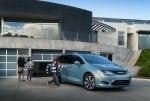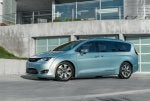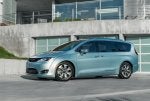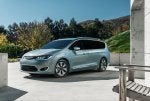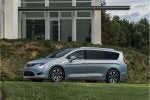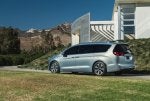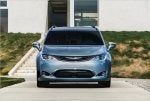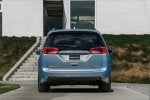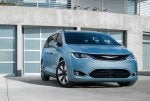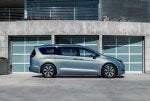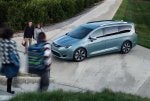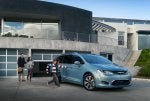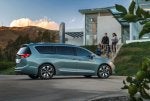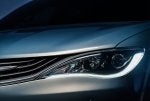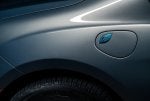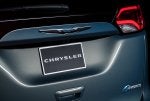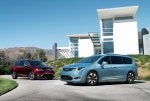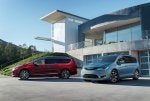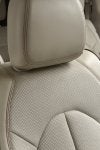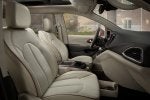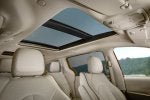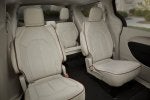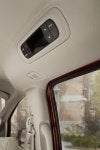
The company that invented the minivan over 30 years ago knows its customers, so when it overhauled its outgoing Town & Country and renamed it, Chrysler called its fuel-sipping plug-in variant simply the 2017 Pacifica Hybrid.
The “Hybrid” name that's meant not to confuse mainstream buyers may on the other hand be slightly confusing to those who follow electrified vehicles because the 30-mile electric range, 80 mile-per-gallon equivalent (MPGe) “Hybrid” is indeed a plug-in hybrid.
Whatever they call it, it breaks important ground in the large family hauler segment that until now got 20-some mpg, and though Fiat-Chrysler (FCA) ceded what on another day might be bragging rights, it has beaten all competitors to a very important market.
What it Is
The Pacifica is a reimagining and repositioning of Chrysler's brand image for the venerable genre of vehicle that's become a staple for those with lots of people and things to carry.
Its name was borrowed from a groundbreaking crossover from recent Chrysler history, said spokesperson Rick Deneau, and the much-anticipated Pacifica Hybrid minivan is to be released fourth quarter this year.

For those of you new to this, the Hybrid's advertised “80 MPGe” in the city is a virtual number to approximate efficiency of electrified powertrains. Its efficiency is about the same on electric usage as a vehicle would be if it got a true 80 mpg on gas.
This “MPGe” figure is in effect while the 16-kilowatt-hour battery stowed under the second row seats is charged. Afterwards the Hybrid seamlessly resorts to regular hybrid operation and has 530 miles estimated total range.
What this also means is the Pacifica Hybrid can run gas-free for 30 miles as would a pure electric vehicle to seriously augment its average gas usage. Its 30-miles range stands to make it America’s second-highest range plug-in hybrid next to the Chevy Volt – or third highest if you count the upscale Volt-based Cadillac ELR.
Hyundai is just releasing a 27-mile midsized 2016 Sonata Plug-in Hybrid sedan which out-does the 19-mile e-range Ford Fusion Energi. These vehicles have batteries sized 9.8 kwh and 7.6 kwh respectively, and the bigger 16-kwh battery in the Chrysler matches that of the 2011-2012 Chevy Volt. It also qualifies for the full $7,500 federal tax credit which is based on battery size – something the Ford and Hyundai cannot claim.
EPA fuel efficiency numbers are not in yet, but Deneau said the numbers Chrysler has provided are expected to be attained, and another number is highway mpg in hybrid mode estimated at a range-topping 28.
Charge time for the battery is a couple hours using 240-volt current, though really, the vehicle can work regardless if one charges it or not. That said, obviously the goal is to recharge and rely on the battery as often as possible. If this is done, its 30 miles all electric travel means this vehicle need never use gas for many ordinary daily driving scenarios.
Government studies have shown three quarters of all drivers travel less than 40 miles daily and Chrysler says the large minivan riding on new global architecture was an ideal vehicle to make into a plug-in hybrid.
Why it’s Important
Until now larger vehicles capable of running all electrically as full or part-time EVs have been exceedingly rare. A few high-end SUVs that plug in are out there, but nothing is available that's mainstream-demographic-family focused.
And among the slim plug-in pickins, none are minivans; in fact no available minivans in America are even regular hybrids.
Although Toyota has for years sold fuel-sipping regular hybrids abroad, and other automakers including Ford, GM, Honda and more could just as well have introduced them also, they have let those opportunities go un-met. Instead they've focused more intently on making smaller cars that were already relatively efficient even more efficient.

This is true although it’s well known big, relatively thirsty vehicles stand to save much more fuel for every mile per gallon improvement, and the Pacifica Hybrid’s capabilities mean it could save lots of fuel under ordinary uses.
The vehicle also now raises the bar in fuel efficiency in a new vehicle segment, and Chrysler has come from behind with no hybrids now for sale, and only the California-market Fiat 500e EV to now challenge everyone else to follow it.
Its press launch expressed the intent to be “disruptive,” and given electrification advocates have decried for years a big gaping hole left unfilled by other major automakers, the term may indeed be fitting.
What’s With the Name?
Deneau said demographic studies indicated the kinds of people who buy minivans may be put off by verbiage like “plug-in" pasted on.
While he did not say so, vehicles like the Chevy Volt have suffered because of misconceptions persisting about its powertrain, and the Volt has endured life under a veritable invisibility cloak to the broader public.
Vehicles badged with “plug” might also be confused with all-electric vehicles, Deneau said, and in turn might induce “range anxiety.”

Squeamish would-be buyers who would otherwise benefit are the last thing Chrysler’s marketers want, so the expedient thing to do was to call its new plug-in hybrid the “Pacifica Hybrid.”
Whether that’s an indictment also on marketing efforts to date or a tacit commentary on the mentality of the American general public, you decide, but these are the facts.
It was easier to just call it a hybrid because hybrids do not have range anxiety, and that type of vehicle has had longer on the market to sink in as unintimidating and green.
Tech Cred
Low-key name notwithstanding, the Pacifica Hybrid uses a a proprietary new electrically variable transmission (EVT) utilizing two electric motors which can both drive the front wheels.
It makes use of a one-way clutch allowing the motor that’s normally only used as a generator to send torque to the front wheels, depending on driving conditions.
Chrysler says the result is increased efficiency, refinement and improved component packaging.

questions about future vehicles. Unknowns do exist, the Pacifica Hybrid may do well and this will remain to be seen
as is true of any car, but that it opens a new vehicle segment that may provoke competitors to follow is more certain.
MPG should be improved in any case as the Atkinson cycle engine gets features like “handed” pistons enabling increased 12.5:1 compression ratio for improved thermodynamic efficiency.
By eliminating the alternator and power steering pump, the engine’s front cover and accessory drive system were able to be re-worked.
Chrysler promises also reduced internal friction along with ignition and fuel injection improvements as also found on the upgraded Pentastar V6 while 2-step valve lift and cooled EGR have been removed with the addition of Atkinson cycle combustion system.
Better Minivan
The company also promises a host of upgrades with a sturdy yet lightened chassis architecture meant to substantially reduce noise inside the vehicle.
Interior space is class leading and it’s of course loaded with all sorts of amenities to make time away from the family living room as tolerable as possible.
The plug-in hybrid’s battery is hidden where the “Stow 'n Go” seats would normally be in the second row so that feature is not available for the Hybrid. The seats are removable, Deneau said, and true to one of Chrysler’s design parameters, the Hybrid can fit a 4 X 8 sheet of plywood.
Early rumors also were that the new plug-in would be all-wheel drive but that was chosen against for this newly launched vehicle, Deneau said. The company has however said this could one day be implemented, but for now it is front-wheel only.
Its release later this year will follow the launch in the second quarter this year of the regular Pacifica variants.
Pricing has not been announced. A premium Town and Country could be in the upper 40s, and the Pacifica Hybrid is to be nicely equipped, but a definitive price won’t be revealed until much closer to launch.
This article appears also at HybridCars.com .































